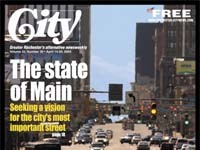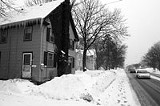[
{
"name": "500x250 Ad",
"insertPoint": "5",
"component": "15667920",
"parentWrapperClass": "",
"requiredCountToDisplay": "1"
}
]
Like all the recent construction nearby, Strong Hospital's new main entrance gives symbolic weight to plans for Rochester's economic future. There's a symbolic turnaround, too. Strong used to put its face more toward Crittenden Boulevard; now it faces Elmwood Avenue. This is painfully evident at rush hour, when Strong and the nearby University of Rochester River Campus --- not to mention businesses and services nearby --- pour out traffic that clogs Elmwood and other streets.
Highway planners are at work right now to relieve the near-gridlock here by reconstructing some roads and links to I-390 and I-590. (The area around Monroe Community College is in the mix, too.)
The planning approach is controversial as well as classic in form. And it raises the usual question: Is it possible to build our way out of a traffic problem, or does increased road capacity merely invite more cars and trucks to fill up the new pavement?
Two miles east of Strong, an imminent highway project may answer this sort of question, one way or the other.
The project concerns the narrower end of Elmwood Avenue --- specifically, the mile-long segment between Brighton's Twelve Corners and Clover Street (New York State Route 65). This segment, only two lanes wide, runs through a leafy residential area. Here the roadway is quite unlike the four-lane Elmwood that roars by the tall buildings of Strong and the campus.
The slim end of Elmwood is no country lane, however. It carries heavy traffic, particularly during morning and evening rush hours.
Some commuters are headed to Clover Street and adjacent neighborhoods; some are entering or exiting the numerous side streets off Twelve Corners. But many drivers, frustrated by near-gridlock along Monroe Avenue, etc., are exploiting a kind of short-cut. There's an I-590 interchange on Elmwood a short distance from Clover, so it's relatively easy to take Elmwood for a short distance, get onto I-590, and then head north or south.
It all adds up to too much traffic, at least some of the time. And this is where the Monroe County Department of Transportation comes in.
The department is now fine-tuning plans to "improve" Elmwood between Hollywood Avenue (a short distance west of Twelve Corners) and Clover Street. The plans entail widening the paved area and upgrading the shoulders and infrastructure. Actual work, says Genesee Transportation Council head Steve Gleason, "will be starting in earnest sometime this year." Planners have budgeted around $3.5 million for the project, he says. According to GTC documents, the federal government will contribute $2.8 million of that amount.
Gleason says the Monroe County DOT has already "advanced" a project design. County DOT staff referred our inquiries to county spokesperson Bob Nolan; the latter did not return a call for comment. But Brighton officials point to the most significant features: The design would add 6-foot-wide paved shoulders to the two existing 11-foot-wide travel lanes. "The pavement will be widened," says town highway and public works superintendent Thomas Low. "But in terms of the area driven upon, it won't be a great deal wider."
Right now, as town officials point out, the shoulders along this stretch are rather "informal" --- that is, unpaved and not delineated. The informality, say the officials, leads some homeowners to think the shoulders are part of their property. In any case, they're not unused. They accommodate bicyclists and pedestrians, after a fashion. (There's a sidewalk on only one side.)
A related problem: The shoulders withstand heavy vehicles that leave the pavement while passing other vehicles on the right. This happens frequently when motorists feel the need to get around left-turning vehicles at minor intersections. The inevitable result is a roadside that's no pleasure for any user --- and that may be a hazard for everyone.
"The beaten-up area will be recaptured," says Thomas Low. He promises an end to "a perpetual conflict" on the shoulder between motorists, residents, bicyclists, and pedestrians. "This really isn't a congestion project," he says --- though he admits vehicles are often "stacked up" at rush hour.
In any case, asphalt will be applied. Brighton town councilmember Ray Tierney notes that under the county design, Elmwood would have a paved surface 34 feet wide. That means the plan will have a large visual impact, even if the width of the right-of-way overall is unchanged. And of course, more asphalt may encourage faster driving.
These and other impacts may account for what Low describes as "a great deal of neighborhood opposition."
Enter the Elmwood Avenue Neighborhood Committee, which aims to preserve the roadway's residential character.
The newly formed group is already in private discussions with county planners, says co-chair Anna Sears. "It's in a holding pattern right now... sort of an impasse," she says. She adds that members are "reticent" about saying more, pending further discussions with planners.
Councilmember Tierney has many thoughts on the project, though. "The county has a good process," he says. And he concedes that "the road is in horrible condition."
But Tierney also criticizes the county's approach. "The neighbors," he says, "are frustrated, and rightfully so, [because] the county took a hard line." How hard? Tierney says county officials indicated they'd do it by the book --- that is, using engineering standards based on hard traffic-flow data, etc. --- regardless of the roadway's individual, special ambience.
The data don't justify a huge overhaul, Tierney believes. As thing stand, he says, engineers have given the roadway decent ratings --- B's and C's on an A-D scale --- for handling the morning and evening traffic loads. "It's not a bleak picture," he says.
Brightonians, says Tierney, would be willing to compromise on 4-foot rather than 6-foot paved shoulders, plus a little more for a rebuilt sidewalk.
More important, he says, planners need to deal with "synchronization" of traffic signals at Twelve Corners and the I-590 interchange. He suspects that small adjustments would improve traffic flow enough to make an extensive rebuild unnecessary.
Over the short and long haul, attention to cross-town patterns may prove even more important.
"We've got a real problem in Brighton with Westfall [Road] and Elmwood," says Tierney. "They both go through really residential areas... What's happened is the economic engine of Strong and the UR. Traffic is obviously going to be a problem."
Elmwood Avenue would make a logical light-rail line --- an important spur to a central north-south line for which a feasibility study has already been done. But there's no "rapid transit" on Elmwood's horizon, says Tierney. "It's going to get worse."
Tierney is concerned about related land-use issues, too. He describes Brighton's efforts to manage growth on former farmland between Westfall Road and the Erie Canal. The town, he says, already controls around 100 acres of the 300 acres of open space there. The 100 acres will eventually become public parkland. But the remaining acreage, he says, may be opened to development as --- or if --- Senator Keating Boulevard is extended eastward toward South Winton Road.
Such development will come at a private cost, however. According to new town guidelines, says Tierney, developers who build along the boulevard will have to pay for any road extension out of their own pockets.
That, he says, is what distinguishes the as-yet-undeveloped parts of Brighton from built-up parts like the Elmwood Avenue corridor. Historically, the public has been socked with the costs of road construction that makes development possible (and profitable). And this in turn has made it harder to put the brakes on unnecessary growth.
Tierney remarks that the spectacular growth of some Monroe County suburbs --- Brighton among them --- seems to contradict population trends. Indeed, US Census data show the county has grown only slightly over the last generation, from 712,000 in 1970 to 735,000 in 2000.
There was a growth spurt here between 1960 and 1970, from 586,000 to 712,000. And not coincidentally, that decade was the Golden Age of the planning style that still motivates the typical roadway "improvement" regime.
Speaking of Brighton, Elmwood Avenue
-

As legal battle over Whole Foods Plaza continues, Starbucks opens on site
Aug 6, 2021 -

Calendar preview: Looking up
Aug 19, 2020 -

Calendar preview: A summer switcheroo
Jul 15, 2020 - More »
Latest in News
More by Jack Bradigan Spula
-

The state of Main
Apr 14, 2004 -
School improvement: the price is wrought
Apr 7, 2004 -
Hour of power
Mar 31, 2004 - More »






